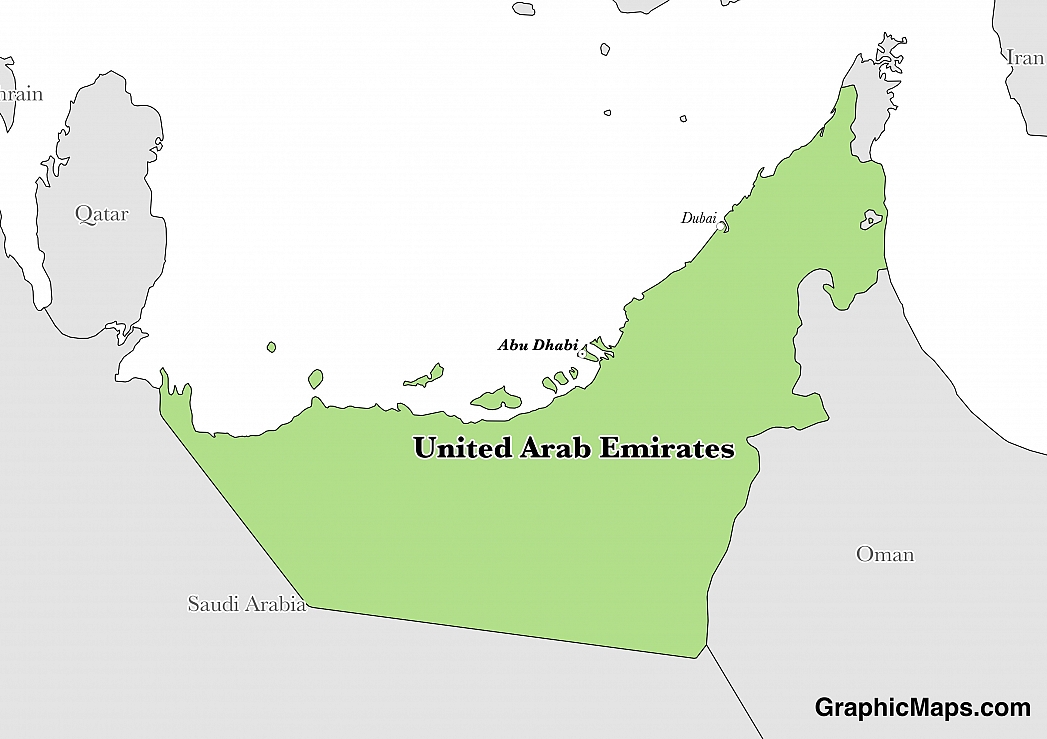Where is United Arab Emirates?
Located in the Middle East, the United Arab Emirates has a 1,066.00 km border with Oman (609 km) and Saudi Arabia (457 km). It has a 1,318.00 km coastline. The boundary agreement between the United Arab Emirates and Oman was signed and ratified in 2003.
Abu Dhabi is one of the Emirates in the UAE, and is the capital city of the UAE. Abu Dhabi got its capital status in 1971 after gaining independence from the United Kingdom. The growth of the city over the years has influenced its population with current figures at 2,784,445. The population is comprised of a high number of non-residents with residents making up only 20% of the population. Tourist attraction sites in the city vary from beaches, outdoor activities, luxury hotels to tours on the island. The city experiences a relatively hot and dry climate with August being the warmest month. Rainfall is minimal in the city with February being the wettest month with an average of 20 millimeters. Strong winds are experienced throughout the year with sandstorms from late May to October. The best months to visit the city are from mid-November to mid-March the weather is favorable for outdoor activities.
Read more on The United Arab Emirates's CapitalThe United Arab Emirates is an Asian country covering 83,600.00 km2. This makes it the 113th largest country in the world and slightly larger than South Carolina; slightly smaller than Maine. Its geographic coordinates are 24 00 N, 54 00 E and Abu Dhabi is the capital city.
The name "Arabia" can be traced back many centuries B.C.
Its ISO code is AE.
Geography
The United Arab Emirates has a mean elevation of 149 m above sea level.
It has a temperate climate that is moderated by prevailing southwest winds over the North Atlantic Current; more than one-half of days are overcast. Its terrain is mostly flat, with sand dunes of vast deserts and mountains in the east.
Population
United Arab Emirates has a population of 5,927,482 making it the 111th largest in the world. The populations is heavily concentrated in the northeast.
Arabic is the official language. The most common ethnic groups are Emirati and South Asian. The majority of the population identifies as Muslim with a significant Christian minority.
The United Arab Emirates uses Arabic as its official language. It is a Central Semitic language. By law, it is recognized as the language in government departments, educational institutions, and in all branches of media. Modern standard Arabic is used in writing official documents, books, newspapers, and magazines. The other version of Arabic used in UAE is the Gulf dialect. As a result of British colonizing the nation until 1971, English is used as a bridging language and is an essential requirement in making job applications. The Arabic alphabet is made up of 28 letters. The language is written from right to left. About 50% of the country’s population speaks Arabic. 30% speak Hindi while 5% speaks Persian. Different verbs are used to distinguish gender, singularity, and plurality. Minority languages used in the United Arab Emirates are Hindu and Persian. Other languages are English, Malayalam, and Urdu.
Read more on The United Arab Emirates's LanguagesThe dialing code for the country is 971.
Government
United Arab Emirates is an independent country. It gained independence from the United Kingdom in 1971. Its constitution was last ratified in 1971.
The UAE is made up of seven Emirates and who all form the National Supreme Council which is the legislative branch of the government. The Supreme council appoints the president who in turn appoints the prime minister. The UAE held its first election in December 2006. The only elective post in the government is of 20 parliament members who are elected every four years. The executive branch is made up of an elected 20 member council. There are no political parties in the UAE.
Read more on The United Arab Emirates's GovernmentEconomy
Factoring in Purchasing Power Parity, United Arab Emirates's GDP is $667,000,000,000.00 (USD) with $67,700.00 (USD) per capita. This makes it the 32nd largest economy and its citizens the 13th richest in the world. The currency of United Arab Emirates is the Dirham (AED).
Its major export partners are Iran, Oman, and Japan. Its main exports are crude oil, natural gas, reexports, and dried fish. Its major import partners are China, India, and the United States. Its major imports include machinery, chemicals, and food.
Flag
The United Arab Emirates is made up of seven different emirates, and they all have one national flag which is made up of four sections and four colors. The flag is rectangular with a red stripe running vertically at the hoist side and three stripes of black white and green running horizontally across it. The flag’s colors are known as Pan-Arab colors, and they each represented an Arabic era. The flag was embraced as the national flag on December 2, 1971. The red, white, black, and green colors of the flag stand for the unification of the seven nations that make up the United Arab Emirates, peace, the strength of the people and the environment and wealth of the nation respectively. Abdullah Mohammad Al Maainah designed the flag. His design was picked from many entries during a competition. The UAE flag has remained unchanged over the years.
Read more on The United Arab Emirates's FlagThis page was last modified on January 17th, 2018
More on Graphicmaps

Published on 2019-11-06
What is a Trade Embargo?

Published on 2019-11-04
Which Two Countries Used to Have the Same Flag?

Published on 2019-09-16
What Is the Only Two-Sided State Flag?

Published on 2019-09-16
Which Country Flag Looks Like the Texas Flag?

Published on 2019-08-29
Flags That Resemble the US Flag

Published on 2019-08-20
